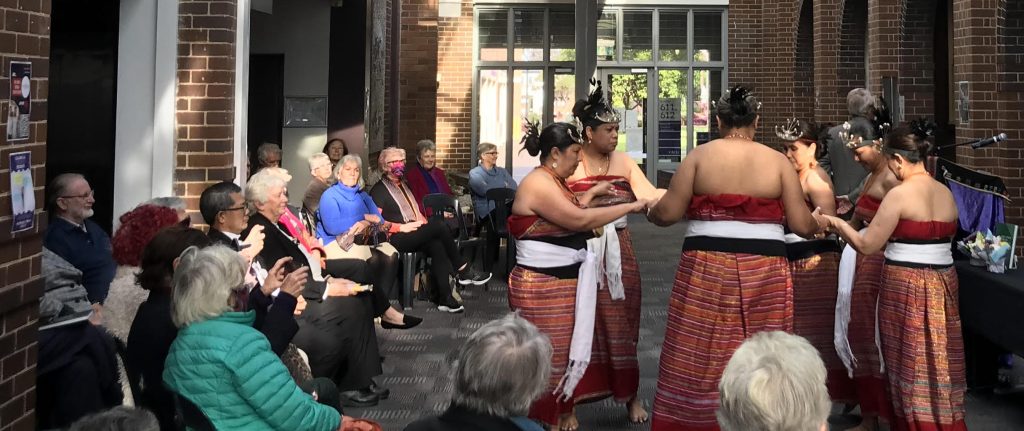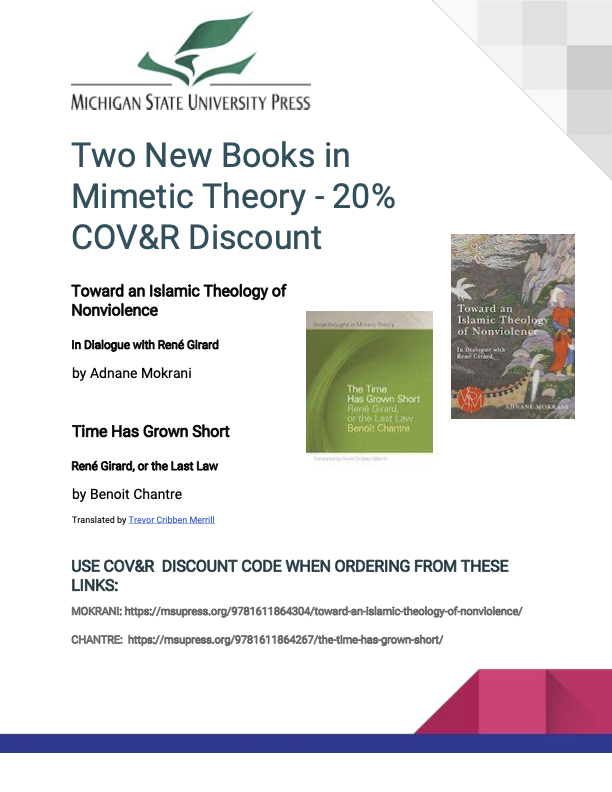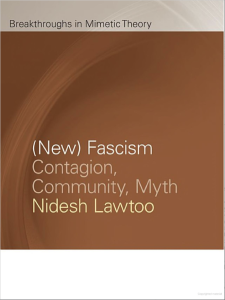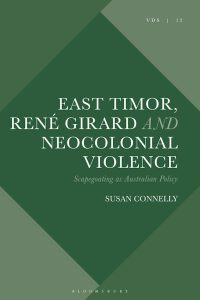In this issue: reflections on our summer meeting, updates on book discounts and a Theology & Peace gathering, reports from members in Spain and Australia, 3 book reviews, and a complete Girard bibliography.

Contents
Letter from the President: Martha Reineke: COV&R in Bogotá,
Editor’s Column: Curtis Gruenler, The Constitution of Friendly Knowledge
Theology & Peace Gathering, November 14-17, 2022
Conference Report: Paul Lynch, COV&R in Bogotá
Partner Update: David Garcia Ramos, News from the Mimetic Theory Research Group in Spain
Letter from… Sydney: Joel Hodge, Celebrating Susan Connelly’s Book on Neocolonial Violence /em>
Membership Update: Book Series on Mimetic Theory from MSUP
Nidesh Lawtoo, (New) Fascism: Contagion, Community, Myth, reviewed by Berry Vorstenbosch
Letter from the President
COV&R in Bogotá
Martha Reineke
Northern Iowa University

The annual meeting of the Colloquium on Violence and Religion in Bogotá, Colombia was an extraordinary experience. On behalf of the COV&R Board and the membership, I want to thank the funders—Imitatio, unRival in the persons of Keith and Suzanne Ross, and our host institution Javeriana University—for their financial contributions and support. I want to express particular appreciation to Roberto Solarte, whose vision for the conference, exemplified most powerfully in plenaries that featured both theorists and practitioners of mimetic theory, enabled us to see anew the compelling relevance of mimetic theory to key issues of our day. I also want to acknowledge the kindness and outstanding organizational skills of Carlos Mora Benavides, the go-to person on many logistics of the conference. The gracious hospitality proffered by staff and employees also was truly exceptional. We could not have felt more welcome in Bogotá and at Javeriana. The 2022 conference, for those of us fortunate to attend, will remain in our hearts forever.
Were I to express gratitude for each plenary speaker, for each participant who offered a presentation, for each person who gave something of themselves in conversation—formally or informally—that has inspired someone else to see the world more inclusively, to be more sensitive to the stranger, to reflect in new ways on the power of mimetic theory to illuminate human experience in hopes of creating a world grounded in forgiveness and committed to peacemaking, my comments would span the entire Bulletin. May I just say that the conference was a stunning success due to the collective impact of the efforts of each and every participant?
All of our annual meetings are meaningful. All make an impact. However, based on what attendees have shared with me during and after the conference, Bogotá will be remembered in the history of COV&R as one of the most significant meetings; perhaps, as time will tell, the most significant meeting in the history of our organization. It will be remembered as such not just because we came to South America for the first time. Rather, in doing so, our physical traversal to Bogotá placed those of us who do not call South America our home in a position to experience the world and to reflect on mimetic theory in ways that would never have happened but for our coming here to this city, to this university, to listen to the people to whom we were been introduced due to the efforts of Roberto Solarte, who took on the enormous task, with his team, of creating the extraordinary experience in which we were privileged to participate.
Setting the context for our conference was an event of momentous importance to the people of Colombia that took place in downtown Bogotá on the opening day of the conference: The final report by the Truth, Coexistence and Non-Recurrence Commission was issued. As part of the 2016 peace agreement between the Government and the FARC-E guerilla group, the commission had been tasked with clarifying the events of the decades-long conflict, promoting and contributing to recognition of victims whose rights had been violated, and promoting coexistence in Colombia’s territories. Eight of every ten people killed during the conflict were civilians. Over 100,000 Colombians remain missing persons. With the election of Gustavo Petro as president, hope is emerging that recommendations included in the report will be implemented. The issuing of the report underscored the significance of conference topics scheduled for discussion: the violence of state security forces, perspectives on mimetic theory from the global south, developments in liberation philosophy and theology, and the impact of decolonization on issues of ethnicity, gender, power, and knowledge.
We were reminded throughout the conference that the situation in Colombia remains fraught, as illustrated by the displacement of thousands since 2016 during confrontations between the ELN (National Liberation Army, a Marxist guerilla group) and a paramilitary group called the AGC. These two groups are fighting for control of coca farming. State security forces have been ineffective in this conflict, and the government up to now has not stopped the violence which has included the murders of thousands of indigenous people, especially leaders and human rights advocates. Entire communities have been forced to flee their homes. Violence has taken the lives of 114 Colombian human rights workers just this year. Notwithstanding the peace agreement, individuals who promote social justice in Colombia today remain at risk.
Conference sessions enabled us to view this history of conflict in the context of mimetic theory. Thanks to mimetic theory, we know that humans desire according to the desire of the other. This conference rendered, unforgettably and transformatively, how colonialism has skewed this structure of desire toward even greater destruction. As Carlos Mendoza-Álvarez explained during his plenary address, colonialism replaces recognition with a spiral of undifferentiating that maintains the privilege of minorities, generating the “invisibility” of the subaltern. Nonviolent mimesis, by contrast, emerges in imitation of a “society in movement” (Raúl Zibechi). A sacrificial logic is overcome through practices of resistance that upend the spiral of hatred and generate new intersubjectivities. Examples of this work were shared throughout the conference by individuals who, notwithstanding ongoing violent mimesis, work to redress violence that has taken the lives of thousands of Colombians and to lessen the economic inequalities that are both the cause and outcome of violence. Participants in base communities build economic opportunities at the grass roots level while responding to paralysis and trauma left in the wake of violence with strategies that promote healing and reconciliation.
My own perspective on Colombia has been shaped by a life lived in privilege in the U.S. In coming to Colombia, I have seen myself in light of that privilege in new ways. What I have read in books about colonialism has become viscerally real. Although notions of manifest destiny are likely still deeply embedded in my thinking, as are ideologies that place citizens of the U.S. at the center of economic and political universe, I now can see more clearly how colonial desire functions to force others to desire according to colonists’ desires. That process has become real as this conference has exposed in ways impossible outside of this context the distortions of the colonial mindset that render the subaltern invisible.
I want to share a particularly revelatory moment at the conference when a powerful memory from a course I once taught on liberation theology surfaced for me during a presentation on peacebuilding at the grassroots. Juan Segundo, as I recall from that course, stated to priests to whom he was writing that, when there is a funeral for someone killed by the paramilitary, photos will be taken. You will be in the photo, or you will not be in the photo. And you will be known accordingly. You will be seen standing with the victims or you will be perceived to be standing with the persecutors. There is no neutral stance. You cannot say you were busy or were called away. Your presence or absence will mean everything.
My students always struggled to understand this passage. Why was it not possible to opt out of taking a position? How could neutrality not be a viable stance? They struggled to imagine what must it be like to live in a society so divided by violence that there is no place of safety and no stance that will be read by others as neutral. I never dreamed when trying to explain this passage to my students that I would ever travel to South America where I would hear for myself voices of individuals who experience the constraints on action of which Segundo wrote. But I heard speakers describing how they have experienced exactly the situation Segundo describes. Their lives have been and remain at risk because they have stood and continue to stand with the victims of violence in Colombia. I understood more than ever had been possible in my classroom how neutrality is a symptom of colonialism that is ethically compromised at its core.
I suggest that the conference called not only me but all of those who attended the conference from countries with histories as colonizing powers to the moment of recognition I have just described. We were invited during the four days we spent together to position ourselves in new ways in the world, to live such as to make Segundo’s words applicable in our own lives: We are in the photo with the victims, or are we are aligned with the perpetrators of violence. For participants in COV&R, the lens now focused on each of us as the camera clicks is mimetic theory. Mimetic theory brings into focus victims in ways that show the force of forgiveness, the power of peace-making, and the capacity of hope to support peace-making.
The work theorists and practitioners of mimetic theory are doing in Colombia, to which Roberto Solarte and his team so generously introduced us, is transforming lives. Theirs is a notable achievement of mimetic theory in application. Conference participants left Javeriana University inspired by what we had seen and heard to find new ways to make a difference in the context of our own lives. No words can adequately convey the depth of our appreciation for this gift of possibility in Bogotá.
Editor’s Column
The Constitution of Friendly Knowledge
Curtis Gruenler
Hope College

Before I explain my title, here is some news about publications and discussions.
First, I was incorrect to say, in the May issue of this bulletin, that COV&R members should have received The Time Has Grown Short: René Girard, or the Last Law by Benoît Chantre, translated by Trevor Cribben Merrill. Rather, this was the first volume in the two series published by Michigan State University Press (Breakthroughs in Mimetic Theory and Studies in Violence, Mimesis & Culture) that was not sent to members automatically. Please see the separate article in this issue about how to receive a discount on this volume as well as Toward an Islamic Theology of Nonviolence: In Dialogue with René Girard by Adnane Mokrani, published in July. How to Think about Catastrophe: Toward a Theory of Enlightened Doomsaying by Jean-Pierre Dupuy is due out in November.
James Alison’s talk from this summer’s annual meeting, “Re-thinking Sacramentality after René Girard: Desire, Sign and the Intelligibility of Crisis,” has been published on his website. Also, thanks for Paul Lynch for his report on the meeting elsewhere in this issue. The plenary sessions from COV&R’s 2021 (virtual) annual meeting are now available on our YouTube channel, and recordings from the parallel sessions will be added as permitted.
The weekly read-aloud on Zoom of the book Saved from Sacrifice: A Theology of the Cross by Mark Heim, hosted by COV&R member Julie Shinnick, has been having great discussions. It meets on Mondays at 6:00-7:30pm Central U.S. time and expects to finish the book, at the current pace, in early November. Newcomers are welcome. Heim’s book is a study from a Girardian perspective of the various atonement theories, treating their historical and theological contexts. As Julie says, “The beauty of a ‘live read’ is that there is no homework and that we can stop to discuss whenever anyone has a comment or question.” Please email Julie at [email protected] for more information and to receive the zoom invitation. Weekly attendance is not necessary; people can drop in as schedules permit. Julie sends a weekly email with an update of the group’s progress.
One of the participants in the read-aloud, Gena St. David, recently published a book, The Brain and the Spirit: Unlocking the Transformative Potential of the Story of Christ, that, as the publisher’s description puts it, “invites readers to embark on a practice of listening to the Christ story through the earpiece of neuroscience.” Julie adds: “Gena emphasizes mimetic theory and how the revelation of the scapegoat mechanism can change us, helping us to evolve.”
All of the back issues of the Bulletin are now available in pdf form on the website of PDC, COV&R’s subscription manager. This makes them more findable and also provides standard archival bibliography including page numbers for citation. Thanks to the two students, Kallen Mohr and Genevieve Gruenler, who helped make this happen.
Be sure to take a look at the new, fiftieth installment of the Bibliography of the Literature on Mimetic Theory included in this issue, which is dedicated to updating the bibliography of René Girard. Dietmar Regensburger, continuing his work of many years, has done a remarkable job of tracking down translations and reprintings and adding weblinks where possible.
Finally, a reminder that submissions for a special issue of Religions on Dramatic Theology are due 5 September 2022.
Okay, my title comes from two books I read this summer, The Constitution of Knowledge: A Defense of Truth by Jonathan Rauch (Washington, DC: Brookings Institution Press, 2021) and God Is Friendship: A Theology of Spirituality, Community, and Society by Brian Edgar (Wilmore, KY: Seedbed Publishing, 2013). Neither says anything about Girard or mimetic theory, but both give me hope for the wider networks of inquiry and community that students of mimetic theory are part of, and to which we can contribute an empowering vision.
Rauch, a veteran journalist, defends truth from the threats he sees on both the political right and left (digital media, disinformation, cancel culture) by showing, in the first half of the book, the robustness of what he calls “the constitution of knowledge,” the principles and practices followed by the single, worldwide network of people—including academics, journalists, medical, legal, and government professionals, and others—who are committed to a common reality. He boils the principles down to two: nothing is ever final, and no one has personal authority. Put the other way round, inquiry always remains open, and every challenge deserves a fair hearing. The network thrives when these principles are embedded in practices that Rauch unfolds by analogy with the American Constitution. These include a commitment to free speech underwritten by his experience as an activist for gay rights, so that he speaks with what James Alison might call the intelligence of the forgiving victim.
Rauch sees “the constitution of knowledge” as a product of the last few centuries. Among his guiding lights are John Locke and James Madison. At the heart of the book, however, is a relational view of knowledge he finds best articulated by Charles Sanders Peirce, a major source for Anthony Bartlett’s understanding of the “transformative semiotics of René Girard” and whose value for mimetic theory was also discussed by Woody Belangia at COV&R’s 2021 annual meeting. From a Girardian standpoint, the modern global network that shares a single, open understanding of reality is one of the products of the Judeo-Christian tradition that has forgotten its source, as Girard suggested about modern science in The Scapegoat. While Rauch does not see participation in this network as incompatible with religious faith (he includes a brief appreciation of Francis Collins, former director of the National Institutes of Health, who has written about being a scientist and a person of faith), he also makes clear why its constitution must be secular. This is the conversation in which mimetic theory must be developed, and to which it could add a clearer understanding of the relational dynamics that make the constitution of knowledge fail, or succeed.
If I were to label with a single word the relational practices by which the constitution of knowledge succeeds, it would be “friendly.” Truth is what we know together freely, and friendships are those relationships we choose freely and in which we taste the fullest freedom (indeed, “free” and “friend” share the same linguistic root). I have written before in this space, more than once, about friendship as a way of thinking about positive mimesis and the conditions for knowing truth. Brian Edgar’s book articulates a compelling Christian understanding of friendship, in dialogue with classical sources, and extends it as a vision, not just for Christian communities, but for public life. His title is from Aelred of Rievaulx, whose twelfth-century treatise On Spiritual Friendship treats friendship as participation in the life of the Trinity in a way that intuits both the positive and negative potentials of mimesis. Edgar draws on the best of both classic and obscure sources from Plato and Ambrose to Bonhoeffer and Derrida. Particularly helpful for me are his discussions of the Bible: not just John 15:10-15 but, for instance, what it means for Abraham and Moses to be called friends of God and for Luke’s description of the early Christian community in Acts to evoke standard elements of the classical understanding of friendship.
Edgar goes so far as to suggest that friendship is the means by which, according to Ephesians 1:9-10, all things will be united in Christ. To Girardian ears, this means that friendship is the antidote, the healing alternative, to the violent means of unity through scapegoating that has been the human norm. How this will unfold remains a mystery, but these two books encourage me to see the coming of peace one friendship at a time, particularly among those who share in mimetic theory’s contribution to the constitution of knowledge.
Forthcoming Events
Theology & Peace Summit
Nashville, TN
November 14-17, 2022

Registration opens September 10 for the 2022 gathering of Theology & Peace at the Scarritt Bennett Center, a conference and urban retreat center on ten peaceful acres just off Nashville’s Music Row. The organizers extend a special invitation to COV&R members: “With so many challenges confronting the world and future generations, this work has never been more important. Join us as we continue to tap the wellspring of inspiration rising out of René Girard’s understanding of what it means to be human beings constructed by our shared desires.” See the Theology & Peace website for more information.
Conference Report
COV&R in Bogotá
Paul Lynch
St. Louis University
The 2022 Colloquium on Violence and Religion in Bogotá, Colombia, was one of the richest, most exciting conferences I have ever been fortunate enough to attend. The excellent plenaries and papers, the lively hallway and mealtime conversations, the cultural excursions to the old city and the shrine of Monserrate: every aspect of the conference was deeply rewarding. Many thanks to our gracious hosts at the Pontificia Universidad Javeriana, especially Roberto Solarte. Their hospitality made everything possible.
The conference opened with James Alison’s “Bird’s Eye View of Mimetic Theory,” offered in Spanish for those new to Girard’s thought. Despite the shakiness of my own Spanish, I could follow most of Alison’s thorough overview, which led to a vigorous discussion among the attendees. One of the most exciting things about this year’s conference was the number of attendees who were approaching Girard’s work for the first time. In the sessions I attended, the presence of these new colleagues led to probing questions and challenging conversations.
Though intended for beginners, Alison’s opening presentation addressed some of the most profound questions raised by mimetic theory, including questions about the security and authenticity of the self. Perhaps one of the easiest mistakes to make in mimetic theory is to slip into assuming that there is a prior self who is then prompted to desire. Alison reminded us that whatever the “self” may be, it is only what it is through the desires of others. The implications of that conclusion frequently returned to my thoughts as I attended sessions on topics as diverse as Gandhi, Haiti, Heidegger, Humboldt, Job, Kant, Mayorga, and of course, the ongoing pandemic. If this still-unfolding disaster should have taught us anything, it is that we are never discrete, autonomous individuals, either anthropologically or biologically. We are made for each other; we are made of each other.
It would be impossible to do justice in this short space to the plenary presentations, which linked mimetic theory to history (James Krapful), literary studies (João Cezar de Castro Rocha), theology (James Alison, Carlos Mendoza, Oscar Saldarriaga, Petra Steinmair-Pösel), and philosophy (Tania Checchi). For me, highlights included Saldarriaga’s presentation on Girard’s dialogue with liberation theologians, which took place in Sao Paulo, Brazil in 1990, memorialized in the book René Girard com teólogos da libertação: um diálogo sobre ídolos e sacrifícios. (The abridged Spanish version is titled Sobre ídolos y sacrifícios: Rene Girard con teólogos de la liberación.) In his talk Saldarriaga recounted the ways in which Girard’s thesis confirmed and extended the insights of his theological colleagues. Together, he writes, these scholars announced to Western Christianity that it had reached the edge of its own apocalypse.
[caption id="attachment_3333" align="alignleft" width="300"] Site of the 2022 conference[/caption]
Site of the 2022 conference[/caption]
Part of what made this presentation especially rich was the follow-up contribution of Alison, who had been present in 1990. One of the most striking things Alison recounted was the language barrier that nearly derailed the meeting. Because Girard spoke neither Portuguese nor Spanish very well, it was decided to have the conference in French. Yet it soon became clear that the theologians’ French was not quite sufficient. It was then decided that the conference would proceed in Spanish, with Girard (who, after all, had been a professor of Romance languages) listening intently so that he could pick up his interlocutors’ meaning. Despite this enormous mental effort, Alison explained, Girard’s attention never flagged, and the dialogue was then able to proceed. As I listened to this story, I was reminded of the conference we ourselves were having, with scholars trying to reach across some of the same languages. The English-speaking guests owe particular thanks to our Colombian hosts for their generous accommodation.
I was also particularly interested in Petra Steinmair-Pösel’s discussion of Pope Francis’s notions of encounter and dialogue. To casual observers (along with some of Francis’s more vituperative North American detractors), these keywords may seem like nothing more than catchphrases or even rhetorical tics. But Steinmair-Pösel’s presentation made clear the depth at which Francis conceives of these notions, which play a constitutive role in his thought. Steinmair-Pösel also keenly observed the Girardian resonances of Francis’s approach to dialogue, an approach that refuses to rival ideological opponents. That does not mean that dialogue cannot accommodate disagreement or even confrontation, but it does mean that dialogue need not mirror resentment or bad faith.
[caption id="attachment_3334" align="alignright" width="300"] View from the conference dining area[/caption]
View from the conference dining area[/caption]
Unlike many academic conferences (at least the ones I attend), it was immediately easy to see the real-world impact of the ideas being discussed. The presentations on Colombian peace-making efforts, along with the work of feminist activists within liberation theology, demonstrated once again that mimetic theory’s insights can reach far beyond the academy. Of special note here was the presentation offered by Dr. Vera Grabe, a former senator, congressional representative, and member of the guerilla group M-19. After leaving M-19, Dr. Grabe became a peace activist and served in several roles in government. Dr. Grabe (echoing the American civil rights activist Martin Luther King) argued that peace is a presence rather than an absence, a presence that must be intentionally cultivated. Her talk reminded me of the need for Girardian scholars to continue imagining expressions of positive, loving mimetic desire.
This year’s COV&R came shortly after Colombia’s presidential contest, which saw the election of the first left-leaning candidate in living memory, along with the election of the first Afro-Caribbean vice president ever. Of particular interest to those in the U.S. is that the election also saw the immediate concession by the losing right-wing candidate, followed by a peaceful transfer of power. Reading about this and hearing more about it while in Bogotá, it was impossible not to think of the deteriorating U.S. political climate, in which “owning” (i.e., scandalizing) the opponent often seems more important than any actual political outcome.
Back home, I am slowly making way through all the book recommendations I received at the conference, including Judith Butler’s The Force of Nonviolence, Pakaj Mishra’s Age of Anger, Walter Wink’s Jesus and Nonviolence: A Third Way, Bernhard Häring’s The Healing Power of Peace and Nonviolence, and Romano Guardini’s End of the Modern World. No doubt other attendees could add more titles. I’m sure we all have our homework assignments as we prepare for next year.
Once again, I wish to express my sincerest thanks to our hosts at Pontificia Universidad Javeriana for their unfailing hospitality and kindness. Thank you for welcoming the Colloquium. I look forward to COV&R 2023.
Partner Update
News from the Mimetic Theory Research Group in Spain
David Garcia Ramos
Catholic University of Valencia
The Interdisciplinary Journal of Mimetic Theory is gradually consolidating its position as a reference in Spanish for the dissemination of works on the application of mimetic theory. In autumn the publication of issue 5 will begin, which will include some of the papers presented at the international colloquium that celebrated the 60th anniversary of the publication of René Girard’s Mensonge romantique et vérité romanesque in 2021. The next issue, which will begin publication in early 2023, will be dedicated to education, social networks, and positive mimesis.
The Spanish research group on Violence and Society will complete this year its research on education and violence with an approach to the new forms of violence at school through social networks. David García-Ramos, David Reyero, and Daniel Pattier, members of the group, have just published a book chapter in which, based on mimetic theory, they propose a reading of the new forms of adolescent identity construction and the role played by social networks in it. In autumn the final part of their research will be developed, carrying out interviews in secondary schools, in which both teachers and students will participate (Reyero, David, Daniel Pattier, y David García-Ramos. “Adolescence and Identity in the Twenty-First Century: Social Media as Spaces for Mimesis and Learning.” In Identity in a Hyperconnected Society: Risks and Educative Proposals, edited by José Manuel Muñoz-Rodríguez, 75-93. Springer International Publishing, 2021. https://doi.org/10.1007/978-3-030-85788-2_6).
The Victims of Terrorism Foundation has granted the group, in collaboration with the Center for International Security of the International Policy Institute and the Robert Schuman Institute for European Studies of the Francisco de Vitoria University, a research project to be led by Blanca Millán. The project consists of carrying out a preliminary study of the phenomena of radicalization associated with new radical tendencies of protest, dissent, or claims likely to generate new violent behavior (verbal or physical) and, therefore, new victims. The project includes two seminars: on September 8, entitled “New forms of radicalization and violence in networks,” and on October 20, with Gil Merom, to reflect on the new forms of radicalization and violence and the role that social networks play in them.
Letter from… Sydney
Celebrating Susan Connelly’s Book on Neocolonial Violence
Joel Hodge
Australian Catholic University
I recently had the pleasure of attending and speaking at the launch of Sr. Dr. Susan Connelly RSJ’s ground-breaking book, East Timor, René Girard and Neocolonial Violence: Scapegoating as Australian Policy (see the review elsewhere in this issue). The launch occurred on Saturday, June 11, in a picturesque setting at Australian Catholic University (ACU), Strathfield Campus (Sydney). There were over 50 people in attendance and approximately 25 people participated via Zoom. Many of the guests were long-standing supporters of the Timorese people.
It was a great celebration of Sr. Susan’s academic work, which applies Girard’s mimetic theory in a novel way to understanding the Australian-East Timor relationship, and of her advocacy work over many years. The book is the twelfth volume in the Violence, Desire, and the Sacred series published by Bloomsbury Academic and dedicated to the global development of mimetic theory. It grew out of Sr. Susan’s doctorate, which was completed at ACU under my supervision.
 The launch began with a number of traditional Timorese dances performed by members of the Timorese community in Sydney. They were dressed traditionally, including in woven tais, and in their cultural welcome and gestures of respect were accompanied by the babadook drum.
The launch began with a number of traditional Timorese dances performed by members of the Timorese community in Sydney. They were dressed traditionally, including in woven tais, and in their cultural welcome and gestures of respect were accompanied by the babadook drum.
Bishop Vincent Long OFM Conv. (Catholic Diocese of Parramatta, Sydney) launched the book and praised it for its important analysis of East Timor as a scapegoat of Australian government policy by utilising and applying mimetic theory. Bishop Long demonstrated an impressive understanding of Girard’s theory, as he had come to appreciate it through Sr. Susan’s work and conversations with him. He compared the Timorese people’s scapegoating and resistance to biblical figures whose apparent insignificance did not prevent their enormous influence: “The small and despised can teach and lead, while the strong need to look and learn.”
 Since Bishop Long had done such an expert job of describing Girard’s insights and how Sr. Susan had used them, I focused my speech on how Sr. Susan had contributed to understanding international relations better, especially in the fields of Australian and East Timor studies. In my speech, I remarked: “No one has examined the relations between East Timor and Australia so comprehensively, bringing together in a clear and sophisticated way the political, historical, anthropological, philosophical, and theological dimensions. If you don’t know much or want to know more about Australia-Timorese relations, this is the book to read.” Sr. Susan utilises mimetic theory in a sophisticated and accessible way to analyse the Australian government’s scapegoating of Timor and its change of policy based on the conversion of public opinion prompted by the non-violent resistance and witness of Timorese victims. It is an important contribution to mimetic theory in the field of international relations and politics.
Since Bishop Long had done such an expert job of describing Girard’s insights and how Sr. Susan had used them, I focused my speech on how Sr. Susan had contributed to understanding international relations better, especially in the fields of Australian and East Timor studies. In my speech, I remarked: “No one has examined the relations between East Timor and Australia so comprehensively, bringing together in a clear and sophisticated way the political, historical, anthropological, philosophical, and theological dimensions. If you don’t know much or want to know more about Australia-Timorese relations, this is the book to read.” Sr. Susan utilises mimetic theory in a sophisticated and accessible way to analyse the Australian government’s scapegoating of Timor and its change of policy based on the conversion of public opinion prompted by the non-violent resistance and witness of Timorese victims. It is an important contribution to mimetic theory in the field of international relations and politics.
Sr. Susan made a moving speech in reply, particularly discussing the impact of Girard’s insights on her own life, thought, and work. “I believe that René Girard is a gift of God to the world of our time, and that his insights can teach every one of us about our imitation, our rivalry and our tendency to violence. Girard discovered the supreme value of the Gospel as the way to follow, advising that unless we imitate Christ or Christ-like figures, we will continue to imitate each other and be constantly thrown back into the old, and increasingly useless, practice of scapegoating.” Sr. Susan even provided some resources for all the attendees to take away and learn more about mimetic theory.
Following the speeches, there was a celebratory afternoon tea provided by the refugee House of Welcome and other generous volunteers. It was a fitting celebration for such a ground-breaking work!
Note: For more on this event, see the articles published by the Sisters of Saint Joseph and The Catholic Outlet.
Member Update
Book Series on Mimetic Theory from MSUP
 COV&R members receive, as a benefit of membership, 20% discounts on books published in two series by Michigan State University Press: Breakthroughs in Mimetic Theory and Studies in Violence, Mimesis, and Culture. The discount code and links to the two most recent publications can be found here. Please use your membership ID to access the discount code.
COV&R members receive, as a benefit of membership, 20% discounts on books published in two series by Michigan State University Press: Breakthroughs in Mimetic Theory and Studies in Violence, Mimesis, and Culture. The discount code and links to the two most recent publications can be found here. Please use your membership ID to access the discount code.
In addition, beginning in October, selections from the back list will be available to COV&R members for a 30% discount with a purchase of three books.
In order to enhance communication to COV&R members about the most recent publications in these series, MSU Press (in consultation with Bill Johnsen, editor of both series, and Martha Reineke, COV&R president) will initiating the following in December, 2022:
- Each December and July an email announcement of the newest publications in the series will be sent to COV&R members from the press.
- A page with the discount code for COV&R members and the most recent list of books eligible for 20% and 30% discounts will be posted on the COV&R website. Members will access the code using their COV&R membership ID from Philosophy Documentation Center.
- Each Bulletin will include an announcement describing recent publications and the link to the discount code on the COV&R website.
MSU Press is a vital resource for the dissemination of scholarship in mimetic theory. Even without a discount, its publications are priced reasonably, making MSU Press among the most accessible resources for scholarship in mimetic theory. When we purchase these publications, we not only support the scholarship of our colleagues in the field now and in the future but also we indirectly support scholarship of mimetic theory more broadly. A rising tide of interest in mimetic theory lifts all boats.
Book Reviews
For inquiries about writing a book review or submitting a book for review,
contact the book review editor, Matthew Packer.
Violence, the Sacred, and Things Hidden: A Discussion with René Girard at Esprit
Jeremiah Alberg
International Christian University

Translated by Andrew McKenna, with a foreword by Andreas Wilmes
East Lansing, MI: Michigan State University Press, 2022
Pages: liv + 84
Many English-speaking readers of René Girard’s work will already know about this text, about its importance in introducing to the public a new dimension of mimetic theory, namely its relation to Christianity, as well as being aware that it was thanks to this interview that Raymund Schwager, SJ, first came to be interested in Girard’s writings. That is reason enough for us to be happy to see this text in translation and to acknowledge our debt to Andrew McKenna for his labors that have resulted in such a fine translation as well as a “Translator’s Introduction,” and to Andreas Wilmes for a concise but penetrating “Foreword.” Thanks to that “Foreword” I will resist the temptation to recount the history of how the roundtable at Esprit came about and precisely how it was presented in the issue. Finally, by way of introductory remarks, I think it worth mentioning that we can all be grateful to William Johnsen and the MSU press for making this available to us in such a handy form.
The book, apart from the “Foreword” and “Translator’s Introduction,” is a translation of the “Discussion with René Girard” from a special issue of Esprit. This discussion includes a sub-section titled “The Astounding Effectiveness of Christianity,” which, according to the “Foreword” was not the original text that Girard presented to the group. “Prior to publication, Girard replaced the initial content of his presentation ‘with a text in extenso he had originally planned as a conclusion to Violence and the Sacred, but then strategically withdrew’” (p. x, quoting from B. Chantre’s “René Girard in France,” Contagion 23 [2016], p. 28). The book also includes a helpful “Appendix: Table of Passages,” which collates the passages from the “Discussion with René Girard” that Girard reused, often without much amendment, in Things Hidden Since the Foundation of the World.
The conversation between Girard and a group of French intellectuals in 1973 is enlightening in several ways. One feels both how far we have moved and how little has changed. The language of structuralism that seems to be near native for most of the participants is further away for most of us. It requires a little more effort to follow what seems to be a “natural” way for most of them to think and express themselves. At the same time, many of the criticisms and concerns about Girard’s work can still be heard today: it is too much, too sweeping, it does not respect disciplinary boundaries, etc.
The centrality of undifferentiation in Girard’s theory, and some of the difficulties in understanding precisely what he means by it, are highlighted in the discussion. Michel Panoff sees this undifferentiation as being more a form of inversion but seems unable to grasp the way the reciprocity (a counterpart to inversion) leads inevitably to sameness. The inversions become so quick that one sees them as a case of undifferentiation.
The question posed by Girard to his interlocutors is one that can still be posed today: “If humans, from the very beginning, have been capable of getting along with one another rationally, been capable of mutual affection, of enlightened self-interest, how have we arrived at the point where we are today” (44)? Girard’s viewpoint is more objective and more hopeful in that it overcomes the delusion that technology is going to save us through some sort of automatic progress.
Maurice Mourier tells Girard that his book “seems based on the refusal, or the elimination, of any notion of transcendence” (48). To this Girard agrees and adds that “its primary aim is to provide a radically sociological explanation of religious thought, to show that in our twofold conception of what we call the ‘ambivalence’ of the sacred, we are in fact dealing with a transfiguration of human violence that was for a long time necessary…” (49). It is this thought that leads him to speak of Christianity and its effectiveness.
Girard lays out the similarity between Christianity and “all other religions” (50). We find the same “mythico-ritual mechanism” in the death of Christ as we find elsewhere. What people have failed to notice is that the very visibility of this mechanism is what makes the Gospels so unique. With this “imperceptible but fundamental reversal … a new logic imposes itself” (51). Christ is not “the mythic reflection of collective transfer,” instead he is the one who has compelled “violence to reveal its game” (52). The desacralized apocalypse that we all live with each day makes Girard’s way of seeing the Gospels even more compelling. Sacrificial protection is collapsing; will we build up a different form of support? Girard does not back off; it is now the Scriptures reading us, not we reading them. We have to learn from them, which presumes a willingness to believe that they could have something to teach us.
This text provides us with more material for reflection on the vexed question of the relationship between Girard’s thought and Christianity. Girard is insistent that there is a scientific moment to his project and that this leads to a consideration of the Judeo-
Christian Scriptures that then turn everything upside down or, as we saw above, “impose a new logic.” No doubt the debate will continue.
(New) Fascism: Contagion, Community, Myth
Berry Vorstenbosch
Dutch Girard Society
 Nidesh Lawtoo, Breakthroughs in Mimetic Theory
Nidesh Lawtoo, Breakthroughs in Mimetic Theory
East Lansing: Michigan State University Press, 2019
Pages: 291
In (New) Fascism: Contagion, Community, Myth, we find Nidesh Lawtoo directing thoughts and concepts he had been developing at an earlier stage in his career to the present-day political scene. In many respects, (New) Fascism reads like an extension of the book Lawtoo published in 2013, The Phantom of the Ego, where he presents “a generalized theory of mimesis that focusses on different forms of mimetic pathos” (293). Also, in (New) Fascism we find many of the thinkers discussed in his earlier book—having Plato at the beginning, paying attention to late-19th century theorists of mass psychology like Gustave le Bon and Gabriel Tarde, and, among others, to French thinkers like George Bataille, Philippe Lacoue-Labarthe, and Jean-Luc Nancy.
In (New) Fascism we switch from the world of modernist literary writers, like Joseph Conrad and D.H. Lawrence, to the election and presidency of Donald Trump, to emerging populist parties in Europe, and to present-day media like the social media on the internet. Up till the last decade, fascism always seemed related to a piece of history largely confined to the first half of the 20th century. Thinking back on the days of the election for presidency in the US in 2000, won by George W. Bush, “there appeared,” Lawtoo writes, “to be no immediate danger looming on the horizon” (xv). But this comforting feeling to be living in a different age has disappeared by now. Fascism is not necessarily destined to return, but things very similar to what caught the attention of modernist thinkers and writers in the early 20th century are taking place right now before our very eyes. Hence the adjective “new” in parentheses, and the urgent feeling that understanding how fascism can arise is more than just an academic exercise.
(New) Fascism is organized in three chapters, reflecting the three themes named in the subtitle. At the end there is a conversation with William Connolly, in which the same material is covered in a less theoretical way. Connolly is a political theorist who has written on democracy, pluralism, capitalism, and climate change and who in 2017 published a book with the title Aspirational Fascism.
In continuing work on a generalized theory, (New) Fascism, then, is not a “Girardian” study in the strict sense of the word. It is not desire Lawtoo is focusing on, but rather the way we are vulnerable to “all kinds of influences, be they positive or negative, therapeutic or pathological, democrat or fascist” (17). One first step is to acknowledge we all share in this “susceptibility to the affective forces at play in fascist mimesis” (201). Crowd behavior is not something to be studied as a phenomenon outside of our own world, but, quoting Serge Moscovici’s The Age of the Crowd (1985): “the crowd is everyone, you, me, all of us.” It is only when we do not exempt ourselves from this predicament, that we become better able to build up resistance.
It is here that Lawtoo’s typical use of the word patho(-)logical—spelled with a hyphen in parentheses in the middle—becomes relevant again. People may be affected by the pathos of an authoritarian leader, to the point that they are dispossessed of their ego’s and become ready to take part in actions they wouldn’t think of being in their own mind. Then we would speak of pathology straight away. But undergoing this pathos can also be used to gain a better understanding of how fascist mimesis works, of, for instance, which registers politicians use for affectively manipulating their audiences.
It is particularly in the chapter on “community” that the rational resistance against the lures of (new) fascist rhetoric becomes problematic. Here Lawtoo takes up the work of Jean-Luc Nancy, who starts his thinking with the writer the final chapter of The Phantom of the Ego is dedicated to, George Bataille. Certainly, Bataille is an outspoken anti-fascist thinker. Rather than privileging “logos” above “pathos”, we find in Bataille a search for counter-communities as an alternative for traditional communities like state and church and their hierarchies. Bataille is one of the founders of Le Collège de sociologie, which was not so much a scientific institution, but something that can be named an “elective community,” presupposed to be tied together with deeper bonds than just a shared interest in knowledge.
And then there was Acéphale, a secret society in which social bonding was studied in undergoing the pathos that brings the subject in tune with communities. The papers presented in these communities, sometimes under the heading of “sacred sociology,” often come very close to crucial insight in Girard’s mimetic theory. Lawtoo even writes: “Given the figures involved, the topic addressed, and the influence of Hegel and Nietzsche, Mauss and Durkheim, one can only imagine that, had he been born a decade earlier, Girard’s name would have appeared among the participants of the Collège” (77).
Still, I must say I have great difficulty picturing René Girard as a participant of the Collège de sociologie. It is not only that Girard was born too late for such a membership, but he also wanted to steer clear from thinkers who can be said to re-embrace the sacred. Certainly, Girard was ready to acknowledge that important intuitions are to be found in thinkers like Bataille and Nietzsche, but if he starts to discuss them, he always does so in a very critical vein. The world of the Collège, and even more so the world of the secret community Acèphale, is also a very dark world.
Certainly, also Lawtoo is aware of this dark side, yet his attitude towards Nietzsche and Bataille is more open than Girard’s. Also, Bataille acknowledges that community-building is something very ambiguous. At the end, in the discussion with Connolly, Lawtoo says that he also used Bataille for “focus[ing] on its darker affective and historical side” in response to “the positive aura that surrounds positive accounts of linguistic communities” (240). Here I can add a personal note: I have bad experiences with some anti-fascist groups in the ’70s and ’80s. The problem seems to be that these groups are usually small and do not provide institutional protection against charismatic figures who are ready to create new scapegoats within the group.
In the chapter on myth, we see another way in which Lawtoo diverges from René Girard. Whereas for the latter, myth is the representation, or rather the misrepresentation, of an original violent founding event, Lawtoo describes myth as the fictions fascist leaders use to affect their audiences. Visions as expounded in Hitler’s Mein Kampf and Alfred Rosenberg’s The Myth of the 20th Century are created in the background of a political program, trying to win the favor of the electorate, or at a later stage to keep the support of the people alive.
Myths then are viewed as creations with an emotional appeal. Erasing the difference between truth and lies—Trump, apart from being both the most productive creator of fake news, also proved to be the most intense accuser of others bringing in fake news—then becomes a strategy for shaping room for affects. The less the truth-value of political fictions counts, the more they can be attuned to visceral feelings. (New) fascist myths of national glory are not about convincing audiences, but about affecting them.
And it is also here the scapegoat mechanism gets in. Connolly, in the conversation with Lawtoo at the end of the book, alerts us to the role of negative feelings: “When Trump engages in the Big Lie scenario, which forms a huge part of his speeches and tweets, followers do not always believe the lies. Rather they accept them as pegs upon which to hang their grievances” (188-189). Here we touch the scapegoat mechanism, not in anthropological terms, but as a psychological propensity to redirect grievances and misgivings to vulnerable groups. In Lawtoo’s approach to mimesis, myths and scapegoat-mechanisms are immediately part of present-day political reality and do not have to be ‘applied’ out of a theory of archaic societies back into the modern world.
So finally, the crucial question in mimetic theory—what do we understand by good mimesis?—resurges in Lawtoo’s book. Whereas René Girard’s answer is exclusively religious, linking good mimesis to Jesus Christ and the communion of saints, creating a chain of nonviolent imitation, Lawtoo’s more secular view is both richer and more ambivalent. Since we cannot evade the suggestibility that helps (new) fascist leaders to power, we must reconsider how to employ our awareness of this. Resistance is not just a matter of having “logos” prevailing over “pathos,” as in Plato’s transcendent Ideas. Resistance also involves finding counter-myths and counter-communities.
Distancing yourself from the crowd may always be valuable. Lawtoo mentions Nietzsche’s walks in the Alps, and here we could add putting yourself on a diet regarding the consumption of new media. But merely distancing might be not enough: “But in practice, since many of us are mimetic creatures living in urban centers, it might be more effective to join others who are already engaged in anti-fascist movements, protests, and in the formation of alternative communities or assemblages. A different form of mimesis linked to sympathy, mutual respect, and solidarity can then not only be nurtured in such environments; the social environment retroacts mimetically on the ego and amplifies anti-fascist dispositions” (204-205).
To conclude, I must say I really can appreciate Lawtoo’s branch of mimetic theory. Emphasis is put on different themes and the whole debate about scapegoating gets directly related to the present-day political and social situation. Though Lawtoo at some points disagrees with Girard or likes to put a different emphasis, he is a writer who does not want to “achever” Girard, but rather wants to extend and broaden mimetic theory, covering subjects that have received little attention up till now. In this sense Lawtoo’s work is really a contribution to mimetic theory.
East Timor, René Girard and Neocolonial Violence: Scapegoating as Australian Policy
Wolfgang Palaver
University of Innsbruck
 Susan Connelly, Violence, Desire, and the Sacred 12
, New York: Bloomsbury Academic, 2022
Pages: 254
Susan Connelly, Violence, Desire, and the Sacred 12
, New York: Bloomsbury Academic, 2022
Pages: 254
Susan Connelly is a sister of St Joseph of the Sacred Heart in Australia. During a book launch in December 1992, she suddenly became aware of the sufferings of the people in East Timor due to its occupation by Indonesia. As an Australian citizen she also immediately realized that Australia, her own country, contributed to this human catastrophe. Looking at the history between 1942 and 1999, Connelly remarks that the Timorese people are “notable among the world’s victims” (p. 7). She mentions that the World War II death toll in this colony of neutral Portugal was at least 40,000 and that during the Indonesian occupation “between 102,000 and 183,000 Timorese people out of a population of 650,000 died […] due to unnatural causes, such as extrajudicial killings, torture and politically induced starvation.”
Sister Connelly soon became a long-time advocate for justice in East Timor. Decades later she began to reflect on this question for a dissertation to become a doctor in theology at the Australian Catholic University. She successfully submitted her dissertation in 2018 and turned it afterwards into this recently published book. It is not only a careful historical study of the relationship between East Timor and Australia but also an important application of René Girard’s mimetic theory to a scholarly field that is not among the typical areas of it. She applies three aspects of mimetic theory to the relationship between Australia and East Timor: “the scapegoat, texts of persecution and conversion” (p. 3). Such an application is quite challenging because Girard discovered the scapegoat mechanism primarily in his study of early religions and not by focusing on the modern world. Connelly overcomes this problem in an exemplary way by using Girard’s understanding of “texts of persecution” for her view of the victimization of the people in East Timor. This is really the perfect way to do it because texts of persecution refer to medieval types of scapegoating against Jews or witches that help us to understand modern scapegoats too. In medieval types of scapegoating, we no longer observe the double transference that comes along with the scapegoat mechanism in early religions turning victims into divinities of the persecuting mob. Texts of persecution are much closer to the way scapegoating is still going on in our world of today. Connelly convincingly shows in her work how East Timor became the scapegoat of global politics and why Australia by its idolatrous emphasis on security was complicit in this victimization.
Methodologically, one of the best parts in this book is a case study that applies Girard’s concept of texts of persecution to the scapegoating of Monsignor da Costa Lopes by the former Australian prime minister Gough Whitlam (pp. 116-123). Martinho da Costa Lopes became apostolic administrator of the diocese of Dili in 1977 until his forced resignation in 1983. He publicly criticized the injustice that caused the sufferings of the people in East Timor. Gough Whitlam attacked Monsignor Lopes in a ferocious verbal campaign which lasted for months. Connelly studies Whitlam’s statements and writings as texts of persecution by addressing those elements that Girard also used in his interpretation of medieval texts: crisis, crime, criteria for the selection of the victim, violent scapegoating, and the restoration of peace. Monsignor da Costa Lopes is rightly uncovered as a scapegoat in this case study. Indonesian military personnel finally pressured the Vatican to remove him from his office in 1983.
Most importantly Connelly does not restrict her study to the fact of scapegoating but, by applying “conversion” as her third element derived from mimetic theory, shows that the people of East Timor are a positive model for the overcoming of violent persecution. Influenced by Australian civil society and by the Catholic Church, Australia slowly started to side with the people of East Timor and contributed to its liberation from Indonesian occupation in 1999. In 2002 the Democratic Republic of Timor-Leste finally became a sovereign state. In Connolly’s afterword, she describes Australia’s conversion pointedly: “Australia […] contributed to immense human suffering, before turning, for one glorious moment, to recognize the Timorese people as the scapegoat” (p. 171). The non-violent resistance with which the Timorese people fought against the occupation significantly contributed to Australia’s conversion. According to Connelly, the conversion had a Timorese inspiration characterized by “non-violence, lack of revenge and openness to reconciliation” (p. 131). She highlights, for instance, that “during the twenty-four-year occupation not a single Indonesian civilian was murdered by a Timorese” (p. 133). Especially the church supported the endurance and non-violent patience of the people. Using William Cavanaugh’s words, Connolly calls this an “ecclesial counter-politics” (p. 133). For the Timorese it was important to tell the truth of those people who became victims without, however, seeking revenge and aiming primarily at reconciliation. Connelly quotes in this regard Xanana Gusmão, an East Timorese politician who became later the fourth prime minister serving from 2007 until 2015: “We advocate a reconciliation process whereby there is justice but which eschews revenge, resentment or hatred” (p. 140).
This book provides a valuable interpretation of the complex relationship between Australia and Timor-Leste, today’s official name of East Timor. It is clearly structured and convinces through its careful argumentation and its sound methodology. The book is also highly readable. Helpful conclusions summarize its main insights at the end of each chapter. Connelly precisely reconstructs the historical development and engages in a critical reading of official documents. She understands mimetic theory properly and skillfully uses it for her interpretation of the relationship between Australia and East Timor. Besides the three main elements of mimetic theory—scapegoating, texts of persecution, and conversion—Connelly also uses concepts like romantic lie or positive mimesis. Susan Connelly shows a profound understanding of mimetic theory by not only drawing on the work of René Girard but also on other experts like James Alison, Joel Hodge, and Raymund Schwager. She also broadens her ethical and theological understanding by going beyond Girard’s mimetic theory with the help of Robert Schreiter’s works on reconciliation.
